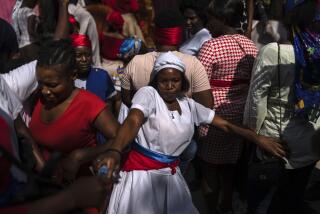The Roots and the Practices of New Cult
To its detractors, it’s a cult that worships old newspaper clippings of the late Ethiopian Emperor Haile Selassie. Or, worse, it’s a menacing and drug-filled black religious sect that preaches violence and revolution.
To its admirers, however, it’s an avant-garde theology of liberation.
But one thing is certain: Rastafari remains a mystery to many.
“Even with reggae music’s recent popularity, it is amazing how little the public knows about the movement’s image,” Rory Sanders, a Harvard Divinity School graduate and Rasta expert, writes in the book, “Reggae International.”
Marcus Garvey Influence
Rastafari’s roots are as deeply embedded in the back-to-Africa movement as they are in the Jamaican slums.
Jamaican-born Marcus Garvey, who later went on to become one of America’s most famous black movement leaders, is credited with giving it birth. Writing in newspapers and speaking from pulpits throughout the early 20th Century, Garvey urged blacks to find glory in the key role that the ancient civilization of Ethiopia played in both the New and Old Testaments. Thus, Africa in general became a glorious black homeland, according to his view. Nowhere did this back-to-Africa movement take hold more strongly than in Jamaica, where a legacy of colonial enslavement inspired many islanders to find solace in their African roots.
The direct connection between Garvey and the Rastafarians can be traced to a prophecy he made one Sunday in a Kingston church: “Look to Africa for the crowning of a black king who shall be the Redeemer,” he exclaimed.
So Jamaican Garveyites watched and waited. On Nov. 2, 1930, they felt the sign from God had arrived when Ras Tafari Mekonnen, who claimed to be the 225th in a line of kings dating back to the son of Solomon and Sheba, was crowned emperor of Ethiopia and took the new name Haile Selassie. To this handful of Jamaicans, the biblical evidence was strong that Selassie was indeed the Messiah whom Garvey had prophesied.
Some preachers in Kingston began to pray to Haile Selasse as the Living God, and his worshippers became known as Ras Tafaris, or Rastamen.
Almost from its inception, Rastafari was seen as anti-Establishment. Jamaican police tried to quell the movement by committing scores of Rastafarians to mental asylums on charges of lunacy. But it didn’t stop the Rastafarians from believing.
Based on the Bible
Rooted in the Bible since most of its original followers were former Christians, the Rastamen interpreted Scripture in a loose way. They referred to God as Jehovah, Jahweh, or simply Jah for short. And Jah was said to be black since Haile Selassie was God and God fashioned his people in his own image. The religion also championed the idea of black supremacy.
Most of Jamaica’s estimated 70,000 Rastafarians generally lead quiet lives in the hills and keep to themselves. Still, no two Rastamen live alike, in keeping with the religion’s strong emphasis on individuality and tolerance.
Many, but not all, refuse to cut or comb their hair (but it is washed) in keeping with their interpretation of the Bible. Some Rastamen are vegetarian or even fruitarians in an attempt to pursue an “I-tal,” or natural, diet; others aren’t. Some avoid all work; others are Jamaica’s finest artisans. Some smoke copious amounts of ganja, the Rasta word for marijuana, seeing it as a spiritually enlightening practice, and even grow it as a cash crop; others don’t use any drugs at all. But nearly all talk in a peculiar Rasta patois made up of created words such as as overstand , the word for understand, and downpresser , which means oppressor; the ever-present pronoun I and biblical references to Babylon and Armageddon.
A Violent Image
Rastafari also is dogged by a violent image. Throughout the Caribbean, police equate its dreadlocked followers with trafficking in the ganja trade or enacting horrific crimes in the name of Jah. Widespread rioting among Rastafarians in Jamaica in the early 1960s helped to brand the movement as antisocial.
Even today, American newspapers often carry Page 1 stories about crimes committed by persons purporting to be Rasta followers. In one highly publicized Los Angeles case in 1982, a Rasta disciple was convicted of the beating and scalding murder of a 5 1/2-year-old girl after he claimed he wanted to put the victim “in the spirit world.” The judge said he couldn’t recall a killing “that made me sicker in the pit of my stomach.”
Today, younger generations of Jamaican Rastafarians want to prove to the world that they are nonviolent and use reggae to spread their message. And the virtual deification of Bob Marley, reggae’s most popular musician and most vocal Rastaman, since his death from cancer in 1981 surely has helped the movement’s reputation.
Increasingly, Rastafari is being regarded more favorably around the world. As Tracy Nicholas writes in the book, “Rastafari: A Way of Life,” it is seen as a religion that “offers approaches and answers to real problems black people face in daily living; it promotes spiritual resilience in the face of oppressive poverty and underdevelopment. It produces art, music and cultural forms which can be universally recognized and appreciated.”
Also, a liberal faction known as the Twelve Tribes of Israel is gaining converts by bringing Rastafari more into the mainstream. Among other things, it is open to people from all races (in the belief that both whites and blacks are descended from Africa) and de-emphasizes the religious importance of both ganja and dreadlocks.
More to Read
Sign up for Essential California
The most important California stories and recommendations in your inbox every morning.
You may occasionally receive promotional content from the Los Angeles Times.










